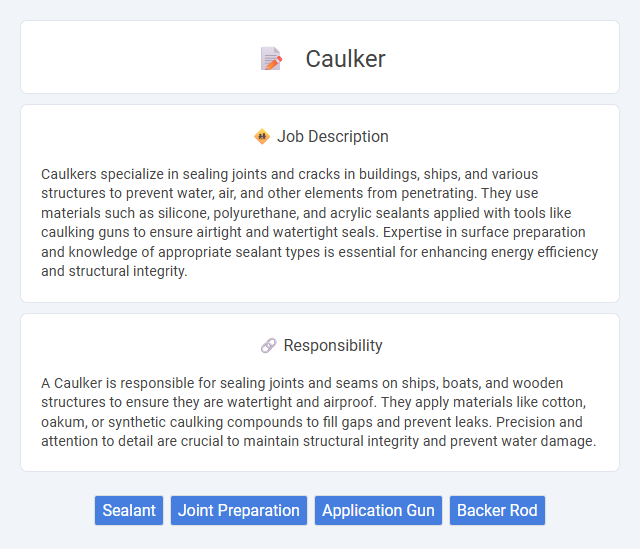
Caulkers specialize in sealing joints and cracks in buildings, ships, and various structures to prevent water, air, and other elements from penetrating. They use materials such as silicone, polyurethane, and acrylic sealants applied with tools like caulking guns to ensure airtight and watertight seals. Expertise in surface preparation and knowledge of appropriate sealant types is essential for enhancing energy efficiency and structural integrity.
Caulking is likely suitable for individuals with good manual dexterity and attention to detail, as the job requires precise sealing of joints and cracks. People who can tolerate working in varied environments, including tight or uncomfortable spaces, might find this job more appropriate. Those with respiratory sensitivities or a low tolerance for repetitive tasks may find the conditions challenging or unsuited for them.
Qualification
Caulkers typically require a high school diploma or equivalent along with vocational training in construction or related fields. Proficiency in applying various types of sealants and understanding building codes is essential for ensuring durable, weatherproof seals. Hands-on experience and knowledge of safety standards significantly enhance a caulker's qualification and job performance.
Responsibility
A Caulker is responsible for sealing joints and seams on ships, boats, and wooden structures to ensure they are watertight and airproof. They apply materials like cotton, oakum, or synthetic caulking compounds to fill gaps and prevent leaks. Precision and attention to detail are crucial to maintain structural integrity and prevent water damage.
Benefit
A caulker's job likely offers significant benefits related to improved energy efficiency and weather resistance for buildings. This skilled trade potentially reduces costs associated with heating and cooling by sealing gaps and cracks, promoting better insulation. It may also extend the lifespan of structures by preventing water damage and drafts, making it a valuable role in construction and maintenance.
Challenge
Caulking work often presents challenges due to the need for precision and attention to detail in sealing joints and gaps to prevent water or air leaks. The probability of encountering irregular surfaces or hard-to-reach areas may increase the difficulty of achieving a clean and long-lasting seal. Skillful application and appropriate material selection are likely essential to overcoming these common obstacles in caulking jobs.
Career Advancement
A caulker specializes in sealing joints and seams in ships, buildings, and pipelines to prevent leaks and ensure structural integrity. Career advancement in caulking often involves gaining expertise in specialized materials and techniques, leading to supervisory or project management roles within construction and marine industries. Pursuing certification and mastering digital measurement tools can significantly enhance job prospects and salary potential.
Key Terms
Sealant
Caulkers specialize in applying sealant materials such as silicone, polyurethane, and acrylic to seal joints, gaps, and cracks in buildings and industrial structures. Their work enhances waterproofing, insulation, and structural integrity by preventing air and moisture infiltration. Effective sealant application by skilled caulkers reduces energy costs and protects surfaces from damage caused by environmental elements.
Joint Preparation
Caulker job involves meticulous joint preparation to ensure optimal sealing and durability in construction projects. This process includes cleaning, debriding, and priming joint surfaces to promote strong adhesion and prevent leaks or structural damage. Proper joint preparation significantly enhances the performance and longevity of caulking materials in various applications such as windows, doors, and expansion joints.
Application Gun
The application gun is an essential tool for caulkers, designed to apply sealants smoothly and evenly in construction and repair projects. Its ergonomic design ensures precise control, reducing material waste and improving efficiency when sealing gaps and joints in various surfaces like windows, doors, and bathrooms. Advanced models feature adjustable pressure settings and easy cartridge loading, enhancing productivity and ensuring a consistent finish.
Backer Rod
A caulker's job with backer rod involves installing this flexible, foam material into joints before applying sealant to ensure proper depth and shape of the caulking bead. Backer rod controls sealant thickness, preventing three-sided adhesion and improving sealant performance in expansion joints, windows, and door frames. Proper use of backer rod enhances durability, flexibility, and weather resistance in construction sealing applications.
 kuljobs.com
kuljobs.com